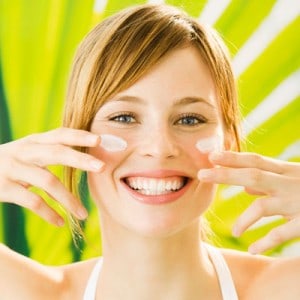Sun Protection 101
Jun 17th 2012

Solar Power: Understanding the Sun and How to Enjoy It While Protecting Yourself!
By now, all those living in the northern hemisphere can probably come out of hibernation. Temperatures are rising, the landscape taking on a palette of greens and with this unfolding of winter into summer, comes our human instinct to want to be a part of it! Whether it’s fishing, hiking, surfing, stand-up paddling, gardening or simply hanging in a hammock, that sweet, golden touch of sunshine quenches something inside unnamable. Sunshine absolutely has its benefits and being outside collecting fresh air in your lungs is priceless. With so many “good-for-you” things, however, sunshine should be approached with some caution and know- how. The sun radiates warmth; it is fundamental in growth and creates dazzling spectacles. On the other hand, the sun can cause sun damage ranging from freckles to deadly skin cancer. Over one million Americans per year are diagnosed with skin cancer in one form or another. Fortunately sun protection has become a huge industry and protecting your skin, your largest organ, from the sun’s powerful rays is pretty straight forward.
To begin, a brief 'Sun 101':
The sun radiates light to the earth and part of that light consists of invisible ultraviolet (UV) rays. When these rays reach the skin, they cause tanning, burning, and other skin damage. Sunlight contains three types of ultraviolet rays: UVA, UVB, and UVC. UVC rays are blocked by the ozone so UVA and UVB are the rays we need to be concerned with. Whether it is a glorious bluebird day or an overcast one, the sun’s rays permeate the ozone and care should be taken regardless of the weather.
Protection:
The first form of protection begins with us; it is a chemical called melanin that is in our skin and absorbs UV rays. People with a lighter complexion have less melanin in their skin than darker skinned people. All people,
 regardless of melanin levels, however, need to ante up to protection, the first being sunscreen. UVA rays are not responsible for the reddening however, UVA is the real culprit of skin aging and DNA damage that goes deep when tanning. When buying a sunscreen, consider purchasing a broad spectrum lotion that protects from both UVA and UVB. UVA rays can only be blocked by these ingredients so be sure to look for them on the
bottle, spray, tube, or stick: zinc oxide, avobenzone and ecamsule. The SPF, sun protection factor, realistically bottoms out past 60 and should begin with at least an SPF of 15. Every part of your body is game for sunscreen, eyelids, ears, hands, toes, lips to name a few. Having a small arsenal of spray, stick, and lotion can make it easy to reach all these places without having sticky hands. Many “daily lotions” have sunscreen in them, buy them. You protect yourself without even thinking about it!
regardless of melanin levels, however, need to ante up to protection, the first being sunscreen. UVA rays are not responsible for the reddening however, UVA is the real culprit of skin aging and DNA damage that goes deep when tanning. When buying a sunscreen, consider purchasing a broad spectrum lotion that protects from both UVA and UVB. UVA rays can only be blocked by these ingredients so be sure to look for them on the
bottle, spray, tube, or stick: zinc oxide, avobenzone and ecamsule. The SPF, sun protection factor, realistically bottoms out past 60 and should begin with at least an SPF of 15. Every part of your body is game for sunscreen, eyelids, ears, hands, toes, lips to name a few. Having a small arsenal of spray, stick, and lotion can make it easy to reach all these places without having sticky hands. Many “daily lotions” have sunscreen in them, buy them. You protect yourself without even thinking about it!
Up next: clothing!
According to the Skin Cancer Foundation, clothing is our very first defense and extremely effective in preventing skin cancer. There is a variety of UV ray blocking clothing. Whether you’re strolling down some little street in Venice, climbing the Grand Tetons, swimming in your favorite lake or going to work, the variety of sun protecting clothing is large. You can boost the strength of your clothes’ UPF (ultraviolet protection factor) absorption by washing them with a product from Sun Guard (www.sunguardsunprotection.com); it actually washes in a chemical sun block that offers UPF 30 and lasts through 20 washes!
A wide brimmed hat can provide shade around the face and shoulders. The brim of the hat should be at least 3” all around to protect not only the face and shoulders but to create shade, thereby protecting your eyes and eyelids. Sunglasses make excellent eye protection, but there are several criteria that need to be met to turn the fashionable into utilitarian. Look for sunglasses that offer UV protection. Wrap around glasses that fit your face are excellent choices for blocking out sun. Protecting your eyes can help prevent cataracts and eyelid cancer.
Other tips: shade.
All light is not the same! Early light and late afternoon light are less harmful than bright sunlight. These times will vary according to season. During the summer, the sun’s rays become powerful after 9:00 AM and will remain so until after 4:00 PM. If you plan to be outdoors during these peak time, then either creating or seeking shade is ideal to protect yourself from UVA/UVB exposure. Trees, umbrellas, bimini tops for boats, canopies, tents, pavilions and overhangs cannot be underestimated for mitigating the sun’s rays. Not only will you protect your skin and eyes, but more than likely you will be more comfortable enjoying the outside in the shade. Your wide brimmed hat or a small rain umbrella can offer on-the-fly shade.
“But I like being tan!” There is a huge selection of bronzers on the market. From lotions to sprays, the technology for creating a tanned look has come a long way from orange. If you choose to use a tanning lotion or spray, be sure that it offers UV protection as some lotions can actually increase damage to your skin.
Sunny skills - Recap:
Creating sun-healthy habits can begin with buying a lotion that offers UVA/UVB protection. Remembering to include your ears and neck are important. Once you have established that routine, you can easily transition to the “big guns” for protecting your skin and eyes when planning outside excursions. Whether you’re going to the office or to the beach, include your arms and hands, especially the arm and hand that you drive with. The proper shades, Sun Guard on your clothing, a daily sunscreen and you’re set. Up the ante when the situation calls for it. Be a good example. No need to broadcast your sun health savviness but take initiative to model how to protect your skin and its importance.
Enjoy the great thaw everyone; the summer is here! Take good care and share this article with others. For more information on preventing skin cancer, visit www.skincancerfoundation.org.

Until next week, sunny skies!
Heidi Aspen Lauckhardt-Rhoades
Writer and Social Media Correspondent
Fitness Professional
Twitter: @ATweetFit


